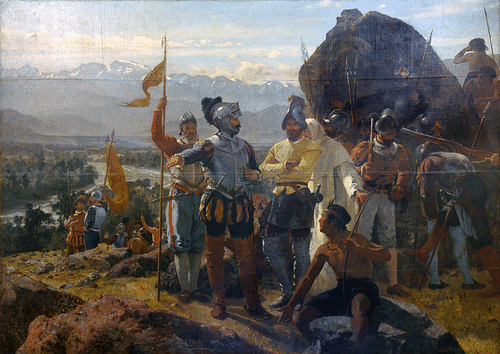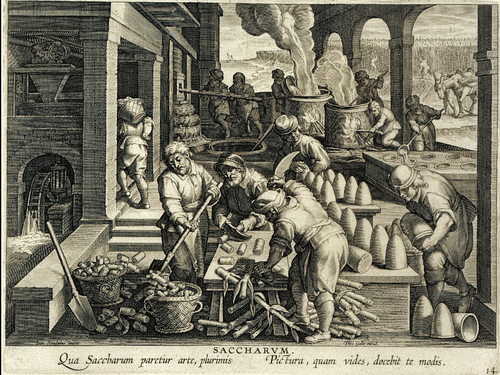
The repartimiento system was a distribution of rights to Spanish colonialists and municipalities, which allowed them to extract forced but low-paid labour from local communities in conquered territories. Designed to replace the inefficient encomienda system, the repartimiento system was eventually only used for crucial industries such as food and cloth production and precious metal mining.
The Encomienda System
When the Spanish conquistadors arrived in the New World in the 16th century, they searched for and shared out the resources they came across. Initially, this was gold, silver, and other precious materials, but as the European colonization of the Americas got underway, labour and slaves became just as valuable. The right to extract labour from a local population – used for working agricultural lands, particularly plantations, and mines – was awarded by the Spanish colonial administration as a license called an encomienda. The license applied to the individual holder and was not tied to any specific area of land, even a town could hold an encomienda. In return for this free labour, the Europeans were expected to give military protection to their labourers and to offer them the opportunity to be converted to Christianity. A holder of an encomienda, therefore, had to fund a parish priest. Although the system was very close to slavery, license-holders could not sell their labourers. The pope had prohibited the slavery of indigenous Americans in 1537, but this scruple clearly did not apply to imported Africans.
From the viewpoint of the Spanish, the encomienda system worked for a while, but it was highly inefficient. Many indigenous peoples, understandably, made attempts to escape. Many were unused and unsuited to working on large-scale agricultural schemes. European-born diseases devastated local populations making it much more difficult to find the labour the Spanish required. Overexploitation of the labourers they could find – literally working and starving them to death – became such a problem that voices in the Establishment back in Spain began to be raised in protest. It was noted, too, that many license-holders did not fulfil their spiritual obligations to their labourers. Bodies like the Council of the Indies, which managed all of Spain's colonies, began to search for a better alternative to the encomienda system. The twin aims of colonization were the extraction of resources and the saving of souls by converting local peoples to Christianity. The encomienda system seemed to be failing on both fronts. The answer the authorities came up with was the repartimiento system.
With rapacious conquistadors and unprincipled settlers eager to extract all they could from colonies, any attempt at change was bound to face practical problems. The first attempt to abolish the encomienda system came in 1542, and a set of New Laws hoped to reduce its application. These attempts failed. The next serious attempt at reform came in 1573 when Philip II of Spain (r. 1556-1598) outlawed any use of the encomienda system in any new territories. Although it was no longer a major aspect of the colonial economy by the end of the 16th century, it was not until the 18th century that the encomienda system finally died out.

Paid Labour & Quotas
The repartimiento system (meaning 'distribution' in Spanish) began to be used in the colonies in the last quarter of the 16th century. The term was borrowed from the practice back in Spain of giving Christian settlers the right to land taken in the Reconquista that had belonged to Muslims. The encomienda system was not immediately replaced, rather it was a case of one system very gradually taking over from another.
Repartimiento labour was still forced, but the worker was now paid a fixed wage. There had been an attempt in 1549 to raise labour by asking indigenous peoples to volunteer themselves where they were needed in return for a small wage. Unsurprisingly, this scheme did not solve the labour crisis. A compulsory system was required based on that which had been used sporadically in the past for larger public works. Under the repartimiento system, local community leaders in every town and village were now obliged to provide a certain quota of labourers from their community. These quotas were fixed by the colonial authorities and were typically around one-seventh of the male population for agricultural labour and 4% for mining (although this later increased to around 25% of the total community population).
Workers were provided on a rotation basis, and so, after a set number of weeks, they could return to their homes and families. Recruitment tended to be less localised than the encomienda system, and much time was wasted in travelling to the place of work to begin the period of labour. Leaders and selected labourers were severely punished if they did not comply with the system. This system was remarkably similar to how both the Inca and Aztec civilizations had acquired labour from conquered territories. Indeed, for this reason, the new system was called cuatequil in Mexico and mita in South America.

In order to gain the right to use such labour, a colonial plantation owner or mine owner applied to their local viceroy, local audiencia (the panel of judges responsible for the administration of a town or area), or the Juzgado General de Indios, the court established to deal with issues related to indigenous peoples. Licenses were usually only granted where the food produced or metals mined were deemed essential to the economy of the colony. This meant that sugar and cloth manufacturing and silver and gold mining took priority. Repartimiento labour was also used for state projects like building and repairing roads, bridges, and public buildings, or draining areas prone to flooding such as around Lake Texcoco. Churches, monasteries, and nunneries were also built and maintained using this system, at least in its early period of implementation.
Local magistrates (juez repartidors) decided which projects qualified for this type of labour and allocated the workers to specific projects. The colonial authorities also dictated the wages to be paid, which were, in any case, always low. Some work in mines required greater skills, and these jobs were better paid than jobs that involved merely breaking up rocks and transporting ore out of the mines to the crushing machines. A further restriction was that the holder of a repartimiento had to be of Spanish descent, while, on the other side, those of mixed parentage (Spanish and Indian) were exempt from being called up to provide labour.
There was another use of the term repartimiento in Spanish America, and this was the repartimiento de comercio. Nothing to do with labour, this system was the right of forced sales to specific indigenous population groups. The original idea had been to make European tools, especially those useful for agriculture, available to indigenous peoples, but it was soon ruthlessly exploited to oblige them to buy lots of practically useless but expensive manufactured goods for the sole profit of corrupt local officials.
Problems & Evolution
In practical reality, many colonists cared not how they acquired labour or how they treated such people, and so the repartimiento system was often little better than the encomienda system. Training and then losing labourers after their short stint was another serious problem and explains why private colonists preferred to use African slaves, who were imported in large numbers. African slaves were used for low-skilled labour, and their numbers grew since slavery was actively encouraged by the state for two reasons: it reduced the negative impact of the repartimiento system on indigenous communities who were more likely to cause unrest, and the state made money on duties it imposed in the importation of slaves.

There was still, too, the very real problem of taking men away from much-needed agricultural work in local communities. The result was that those left behind had to work harder and longer, with the inevitable result that small-scale, traditional agricultural output declined. The tribute system still continued where goods or a cash equivalent were extracted from local communities, and this was now made much more difficult to provide by reduced and disrupted local farming communities. Some communities, for these reasons, did refuse to provide their quota of labourers.
As the colonial authorities gradually realised they could not effectively govern a subject population without a massive investment of force, the repartimiento system became restricted to larger projects like the mills and mines as the 17th century wore on (although the system was not finally ended until around 1820). The silver mines of South America were insatiable in their demand for labour, and their awful working conditions became a particular point of contention between community leaders and the colonial authorities. There were attempts to at least limit repartimiento labour to less dangerous and health-hazardous tasks. In 1609, for example, a new labour code prohibited the use of repartimiento labour for the more dangerous jobs using complex machinery in manufacturing mills, in deep pearl-diving, and operating systems for mine drainage. These jobs were reserved for slaves or convicts.
There were, too, some curious scruples (considering contemporary attitudes on other matters), for example, that repartimiento labourers should not be used as porters. In territories where wheeled vehicles were still rare and often unusable, humans had been used as beasts of burden for millennia, but the Spanish decided this was no longer acceptable and prohibited the practice. Mules and llamas were used instead, but old habits die hard, and many local communities continued to use human porters (as they still do today).
Despite the drawbacks, both slaves and low-wage repartimiento labour allowed European settlers and settlers of European descent to live well. There were plenty of problems to be faced by landowners besides labour sources, but eventually, their success was seen in the evolution of a new system of managing land and resources. This was the establishment of vast estates or haciendas where agriculture often gave way to less labour-intensive activities like stock-raising (cattle and sheep). The growth of such haciendas may have reduced the risk for some indigenous people of being exploited for their labour, but they often took their land, forcing them to live in designated areas far from their traditional environments and cultural roots.
The repartimiento system accelerated the transition of many communities towards a cash-based economy and created the means to meet the rising demand for European-style goods. Missionaries and missions provided some rudimentary education, but persistent attempts to Christianise the population, the promotion of European customs, and the disruption of traditional life based on the agricultural cycle all took their toll on indigenous cultures. A way of life that had flourished for centuries was eventually swept away in all but the remotest parts of the Americas. As the historian J. H. Parry notes: "In general terms, for the great mass of settled peoples in many, perhaps in most parts of the Spanish Indies, the incursion of Europeans produced an economic, and above all a demographic catastrophe" (114).






